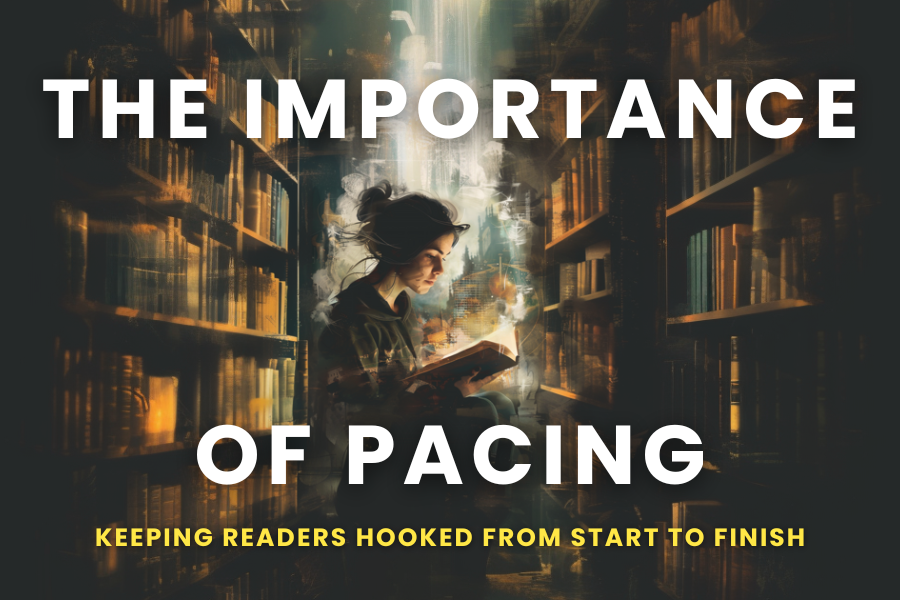The Importance of Pacing: Keeping Readers Hooked from Start to Finish
Pacing is the heartbeat of storytelling. It's the rhythm that guides readers through the narrative journey, dictating when to speed up for excitement and slow down for introspection. Mastering pacing is essential for any writer aiming to captivate their audience from the first page to the last. In this article, we'll explore the importance of pacing in storytelling and how it can keep readers engaged throughout the entire journey.
The Role of Pacing in Storytelling:
Pacing refers to the speed at which a story unfolds. It encompasses everything from the length of sentences and paragraphs to the timing of major plot points. Effective pacing is crucial because it controls the tension, maintains reader interest, and ensures that the narrative flows smoothly.
📍 Setting the Tone: Pacing sets the tone for the entire story. A fast-paced opening grabs the reader's attention and creates a sense of urgency, while a slower pace can evoke a more contemplative mood. Consider the difference between the brisk, action-packed beginning of a thriller novel and the leisurely introduction of a literary fiction piece. The pacing immediately informs readers about what kind of experience they can expect.
📍 Building Suspense: One of the most powerful tools in a writer's arsenal is suspense, and pacing is key to its creation. By gradually increasing tension through a series of carefully timed reveals and cliffhangers, writers can keep readers on the edge of their seats, eager to uncover what happens next. Think of how suspense builds in a mystery novel as the protagonist uncovers clues or in a horror story as the protagonist ventures deeper into the unknown.
📍 Developing Characters: Pacing isn't just about action; it's also about character development. Slowing down the pace allows for moments of introspection and emotional depth, giving readers insight into the protagonist's thoughts, feelings, and motivations. These quiet moments are essential for building empathy and understanding between the reader and the characters.
📍 Controlling Momentum: Like a rollercoaster ride, a well-paced story has its ups and downs. It accelerates during moments of high stakes and slows down during quieter, more reflective scenes. By carefully controlling the momentum, writers can prevent readers from becoming overwhelmed or bored, ensuring that they stay engaged from start to finish.
📍 Satisfying Resolution: Pacing plays a crucial role in delivering a satisfying resolution. As the story approaches its climax, the pace quickens, driving towards a dramatic conclusion. Afterward, the pace gradually slows as loose ends are tied up and characters reflect on their journey. This gradual deceleration allows readers to savor the resolution and provides a sense of closure.
Techniques for Effective Pacing:
Now that we understand the importance of pacing, let's explore some techniques for mastering it:
📍 Vary Sentence Lengths: Short, punchy sentences can create a sense of urgency and momentum, while longer, more descriptive sentences slow down the pace and provide detail.
Examples include:
Short Sentences: "The footsteps echoed in the empty hallway. He glanced behind him, heart pounding. No one was there."
Longer Sentences: "The old mansion stood tall against the night sky, its windows dark and foreboding. As he approached, a chill ran down his spine, and he couldn't shake the feeling that he was being watched."
📍 Use Dialogue: Dialogue can inject energy into a scene and break up exposition, keeping the story moving at a brisk pace.
Examples include:
"Get down!" John shouted, pulling Mary behind the crumbling wall. Bullets whizzed past them, kicking up dust.
"What do we do now?" Mary asked, panic rising in her voice.
"We wait," John replied, eyes scanning the battlefield for any sign of movement.
📍 Employ Cliffhangers: End chapters or sections with cliffhangers to compel readers to keep turning the pages.
Examples include:
Chapter Ending: "With a sudden twist of fate, the door creaked open, revealing a figure standing in the shadows. But before she could see who it was, the lights flickered out, plunging the room into darkness."
This leaves readers wondering who the mysterious figure is and what will happen next, compelling them to turn the page to find out.
📍 Experiment with Structure: Play with the structure of your narrative by alternating between fast-paced action scenes and slower, more reflective moments.
Examples include:
Fast-Paced Action Scene: A car chase through the bustling streets of a city, with short, adrenaline-fueled paragraphs describing each heart-pounding moment.
Followed by...
Slower, Reflective Moment: The protagonist takes a moment to catch their breath, reflecting on the choices that led them to this point and the stakes of the situation.
📍 Trust Your Instincts: Ultimately, pacing is an intuitive process. Trust your instincts as a writer and pay attention to how different pacing choices affect the overall flow of your story.
Examples include:
As a writer, you may instinctively feel that a particular scene needs to slow down to allow for emotional depth and character development. Trusting this instinct, you dedicate a chapter to exploring the protagonist's inner turmoil, even though it doesn't directly advance the plot. This decision pays off as readers connect more deeply with the character and become more invested in their journey.
Pacing is the invisible hand that guides readers through the twists and turns of a story, keeping them hooked from start to finish. By mastering the art of pacing, writers can create immersive narratives that leave a lasting impact on their audience. So next time you sit down to write, remember the importance of pacing and let it be your guide on the journey to storytelling greatness.
By incorporating some of the tips above, you are bound to hook your readers till the very end.

